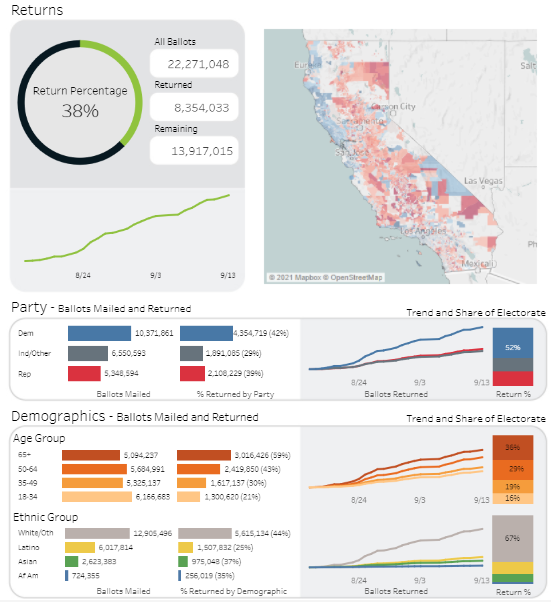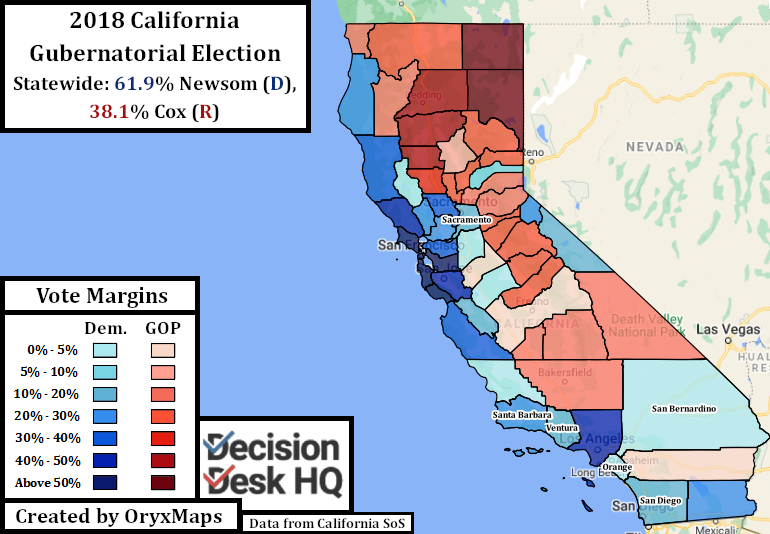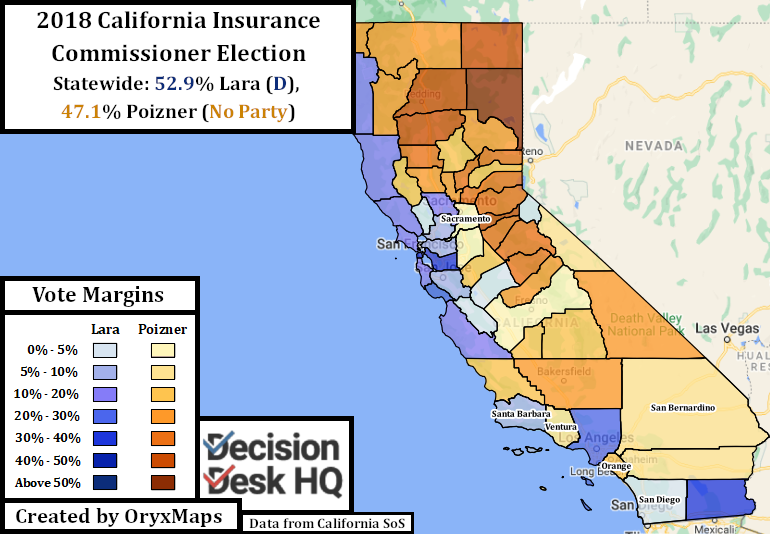Two months have passed since Decision Desk Headquarters previously examined the September 14th California gubernatorial recall. We published that article before California restored Coronavirus safety measures in response to the arrival of the Delta variant, before seasonal wildfires spread throughout the state, and before California reentered a drought.
We noted earlier that one or more environmental crises beyond the control of politicians could damage Governor Gavin Newsom’s retention campaign. For a while it appeared that the emergency measures did benefit the recall effort. Then the race became nationalized and California’s immense Democratic electorate finally paid attention to the election. The race returned to an overwhelming lead for the Newson’s retention campaign. It is now likely that Newsom remains in office with a margin of victory in line with California’s overwhelming Democratic lean.
A Period of Uncertainty
Voter reaction to pandemic policies allowed petitioners to obtain the necessary signatures to trigger a gubernatorial recall. Conservatives rebelled against the intrusive mask mandates, lockdowns, and Governor Newsom’s perceived personal hypocrisy. Yet the inertia necessary to verify all statewide petition campaigns meant the recall would occur nine months after the precipitous French Laundry incident of November 2020. California reopened on June 15th, had high vaccination rates, low numbers of hospitalizations, and the state implemented its own stimulus checks. The election appeared uncompetitive.
Yet the Coronavirus resurged with the Delta variant, necessitating the restoration of indoor mask mandates and reminding recall advocates why they opposed Newsom. This coincided with an ongoing drought and the proliferation of wildfires. While polls found few voters personally afraid of the natural disasters – both crises intensely affect voters in the Central Valley and rural areas but barely matter to urban and suburban residents – the combination of crises motivated California’s minority Republican voters. Early polls narrowed, but not because Democrats were voting for the recall. Newsom remained popular. Republican voters responded with an extreme desire to turnout and vote, while polled Democrats displayed lukewarm responses. This enthusiasm gap did not last.
Recall voters additionally consolidated around a preferred replacement candidate. Previously no single replacement candidate commanded a consistent percentage of support. The California Republican Party refused to endorse any potential replacement for fear of damaging turnout among other Republican candidates’ supporters. Out of this vacuum, conservative California talk radio host Larry Elder emerged as the preferred candidate for both grassroots conservative donors and energized recall voters. Elder’s prominent background within Republican circles gave him the name recognition to compete statewide and his vocal support for former President Trump drew support from popular national Republicans.
Return to Retention
In response, Governor Newsom’s retention campaign and the California Democratic Party tied the recall to the national Republican brand that the majority of California voters despise. This was always the Democratic strategy, but the emergence of Larry Elder intensified this association. Newsom no longer had to defend his record on prominent issues like homelessness or housing affordability: there now was a defined candidate attached to the recall campaign. Nationalization increased Democratic voter enthusiasm and restored Newsom’s large polling lead.
Nationalization came in two forms. First, Elder espouses views anathema to the wider Californian electorate. These include repealing the minimum wage, belief that the 2020 presidential election was stolen, and ending vaccination and mask mandates – all proposals opposed by a supermajority of California voters. Newsom and Democrats amplified Elder’s positions and tied them to the broader recall campaign. Elder unintentionally assisted Democrats by campaigning as an uncompromising partisan. Elder publicized his intent to replace Senator Feinstein with a Republican and his support for Texas’s recent abortion law, both of which were quickly spread by the press and magnified by the Democratic campaign. The recall campaign transformed from a referendum on Newsom’s tenure into a referendum on Larry Elder’s views – a referendum that California Democrats will always win.
Second, prominent national Democrats from all wings of the party attached themselves to the “No” campaign. U.S. Senators Bernie Sanders and Elizabeth Warren both appeared in ads opposing the recall to stabilize Newson’s lagging support among California progressives. Vice President Kamala Harris and Senator Amy Klobuchar campaigned with Newsom during the first week of September, Alexandria Ocasio-Cortez told her followers through social media videos to retain Newsom, and President Biden appeared at joint Long Beach rally on September 13th. Only in a few other states would inviting outspoken members of prominent factions benefit a campaign. California’s size and diverse electorate however allows the campaign to micro-target their messengers to receptive communities.
What to Expect on Election Night
California has a reputation as a state that takes weeks to count its votes, with final results only known a month after polls close. This is an unjust and unfair characterization of California’s electoral process. In 2020, California counted 71% of the final vote within 24 hours of poll closing, with the majority of the remainder counted over the next few days. The state processed enough votes to call the major races within a few hours. The lagging vote counted over the next few weeks mattered only for tight contests. It is these elections – usually Congressional – that receive national attention which skew public perceptions.

As of September 13th, 8,354,033 voters have returned recall ballots. 52.1% of returned ballots are from Democrats, 25.2% are from Republicans, and 22.7% are from Independents or other parties. This is a gap in party registration comparable to that seen in the leadup to the 2020 general election, with a marginal Democratic uptick at the expense of Independents’ turnout.

Newsom will receive better results from the early vote when compared to the final results. It will not, however, be a dramatic overperformance. 69% of 2020 votes were received and verified by county boards before election day, making up the bulk of immediately processed votes. That initial count gave Biden 65.1% of the vote, just 1.6% more than his final result. The early vote is expected to be a larger share of the final total when compared to 2020, because California counties mailed a recall ballot to every registered voter. The count is also expected to be quicker since the ballot is significantly shorter. With a comparable electorate to 2020 it seems likely the result of the recall election will be known within a few hours of poll closing, even if an official projection takes a day or two.

There are two different benchmarks to keep in mind when examining recall results. First: will Newsom be retained or replaced? Second: if Newsom is winning, as polls expect, how much will he win by? Two good races to look at for guidance are the 2018 Gubernatorial Election, and the 2018 Insurance Commissioner election – the narrowest statewide California election that year.

These two 2018 races suggest Sacramento County in the Central Valley and Santa Barbara County along the Central Coast are good barometers for a 50-50 statewide race. If Retain is winning handily in both Sacramento and Santa Barbara Counties, then it will win statewide.
To answer the second question, one must examine several indicators. The counties to watch are all in Southern California: San Diego, Ventura, San Bernardino, and Orange in that order. All of the counties are Democratic nationally, but all favor the Republicans when compared to California’s 30-point Democratic statewide landslide. If Retain is winning San Diego then it is on track to win by about a 10% margin, and if it is winning in Orange, then Retain will likely win by more than 20%.
The replacement ballot will not be required if Newsom’s retention campaign wins the first question, but the second question still provides interesting data. The official Democratic position is to leave the replacement ballot blank, a position designed to emphasize the differences between Newsom and his Republican opponents. Larry Elder will likely win the most counties through lack of opposition. He could win all the counties if Democrats followed the party line and did not vote for one of the no-name replacements with a Democratic party preference.
The number to keep an eye on is the total number of second question votes when compared to the total number of first question votes. A significant discrepancy, or undervote, is expected as Democrats skip the second question. The size of this undervote will give an estimate of how many lockstep partisan Democrats there are in the Golden State.
What Happens Next
The 2021 gubernatorial recall will not end with the projection of the winner. Both camps are already preparing their post-election strategy. Elder – with the tacit approval of former President Trump – is already preparing to declare the process rigged and fraudulent. This message is what his die-hard base and national allies want to hear, even though a failed recall was always the most likely outcome in Democratic California.
State Democrats, meanwhile, are preparing to reform the recall process and make it harder to trigger these petition elections. Reforming the system requires citizen approval, so the changes – if proposed – would likely appear on the 2022 midterm ballot. Campaigners would then have a favorable electorate open to preventing Republicans from forcing recalls opposed by the majority of voters.
Ben Lefkowitz (@OryxMaps) is a Contributor to Decision Desk HQ.